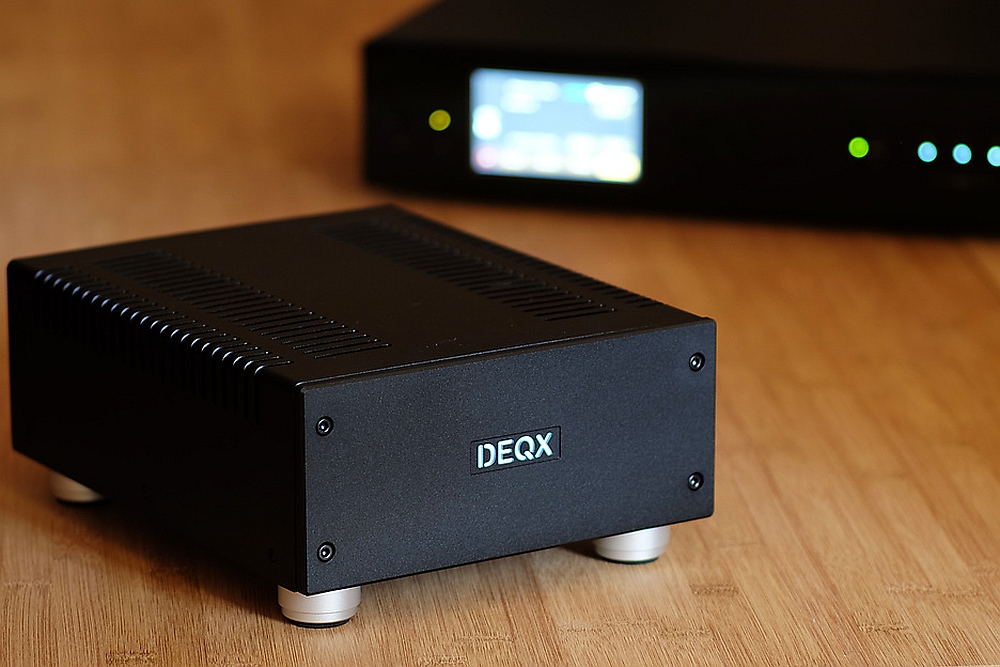Reviewer Barry Jones recently spent some time at DEQX’s Sydney headquarters where he met with Founder Kim Ryrie and General Manager Alan Langford to discuss the company’s rich history, its proprietary digital technologies and highly advanced processors. DEQX’s unique and refined products has seen the digital specialist grow into a powerful force in the digital signal manipulation field.
DEQX’s processors have evolved to a high level of automation and sophistication, with the DEQXpert online assistance service now making the products even easier to incorporate into any system context. DEQX’s processors offer digital speaker correction, post-speaker-calibration room acoustics correction, high quality in-built analogue-to-digital and digital-to-analogue converters, linear phase crossover and equalisation technology, network streaming capabilities and much more. Recently, DEQX released a line of Class-D amplifiers using Ncore technology and featuring three configuration options.
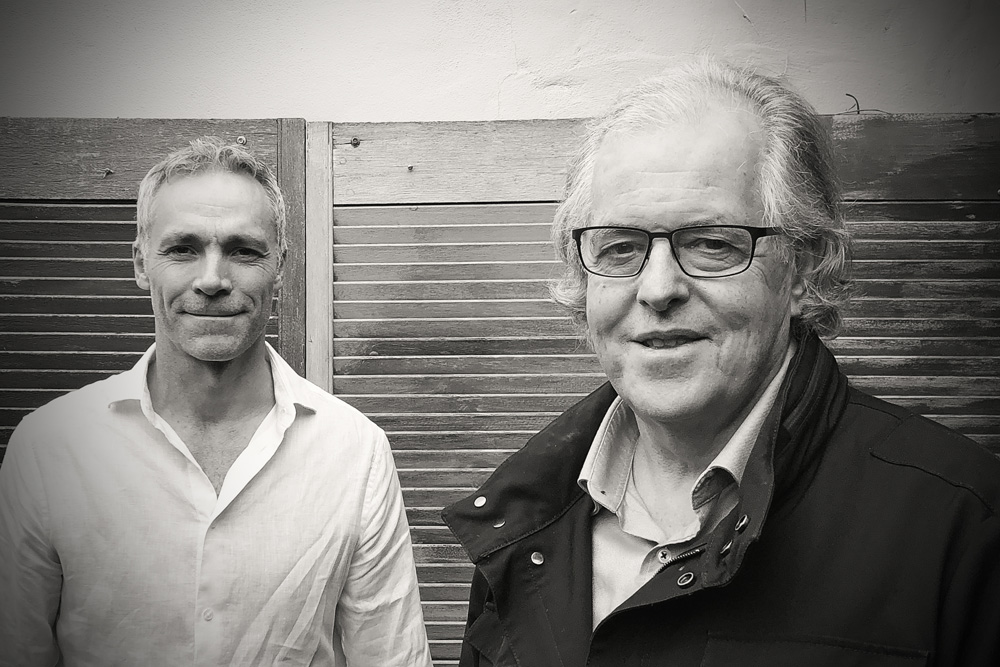 SoundStage! Australia writer Barry Jones (left) with DEQX’s Founder Kim Ryrie
SoundStage! Australia writer Barry Jones (left) with DEQX’s Founder Kim Ryrie
Barry Jones started off by asking Kim Ryrie about his background, the subsequent birth of DEQX and what it is that underpins the company’s products.
Kim Ryrie: I started a Hi-Fi magazine in around 1972 ‘Hi-Fi Review’ and before that another magazine ‘Electronics Today International’ (ETI) that reviewed Hi-Fi. We employed Louis Challis & Associates in Sydney, who did the measurements. I was staggered by how bad the performance of loudspeakers were, we are talking a long time ago when we were about 20 years into hi-fi, compared to amps and other components.
For a while I had a go at making speakers, I was part of a rock band and we needed a PA system, so I built some using Altec ‘Voice of the Theatre’ speakers. They had a 15-inch bass driver with Altec’s passive crossover to a high frequency horn. The horn’s compression drivers would blow fairly often but, for live shows, we were able to replace the compression driver’s diaphragm pretty quickly. One of the ETI DIY projects we did was a 100 watts amplifier that gave me the idea to make the speakers ‘active’ with two of the amps into an active crossover using steeper slope 24dB per octave filters. The improvement was so dramatic I couldn’t believe it. I wondered what was going on here – Altec designed the famous Voice of the Theatre passive crossover so that’s as good as it gets – why did the DIY ‘active’ arrangement sound so much better? The dynamics were better; the horn drivers stopped blowing up and the speakers played louder and cleaner. So in my naiveté I assumed the world would soon be changing to active (this was the 1970s) and of course the Professional Audio world did, but not consumer Hi-Fi.
Shortly after that I started Fairlight Instruments with school friend Peter Vogel and we designed a synthesizer called the Fairlight CMI (Computer Musical Instrument). This could synthesize sounds from up to 32 harmonics but it became famous because it was also the first ‘sound sampler’ with the first integrated music composition language. So you could record any acoustic sound and play it on the keyboard and you could edit in real-time, so it recorded and multi-tracked keyboard performances and rhythm sequencers could be constructed on the fly.
In the design process we’d been lucky to meet Tony Furse who had designed a dual microprocessor system. He’s also developed some of the electronics for manipulating sound waveforms. It had been a hobby for Tony for years but he had to move on to other work so he let us take it over. We redesigned it over the next few years and ended up with the first parallel microprocessor system anywhere according to Motorola. About a year before the first Apple.
Tony had designed a light-pen controller for our monotone green graphics display as the mouse was yet to be invented. We even had to build our own alpha-numeric keyboards out of individual Honeywell switches. In fact we had to have every letter and number engraved onto the key tops! The dual 8-bit processor manipulated 8-bit waveform memory with 8-bits to control the amplitude, so we had a pseudo 16-bits of audio!
With 8-bits we always had 1 percent distortion... and that’s ‘best case’ when all bits were used. One percent distortion means you have 40dB of resolution before distortion harmonics appear that mask the detail below 40dB but a lot of people in the rock business liked that sound. Our first customers were Stevie Wonder, Herbie Hancock, Hans Zimmer, Peter Gabriel, Ice House, Conservatorium of Music in Sydney and Adelaide, Kate Bush and Fleetwood Mac. They were paying about US$25,000 in about 1980.
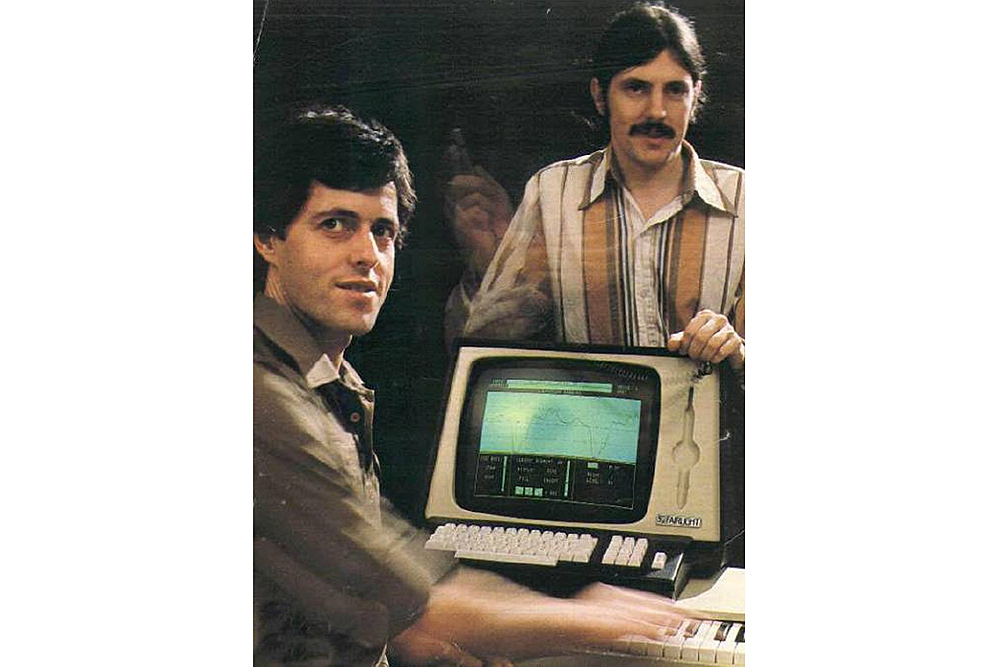 Kim Ryrie and Peter Vogel, creators of 1979’s Fairlight CMI, which revolutionised the recording industry (Photo courtesy of DEQX and Australia's National Film and Sound Archive)
Kim Ryrie and Peter Vogel, creators of 1979’s Fairlight CMI, which revolutionised the recording industry (Photo courtesy of DEQX and Australia's National Film and Sound Archive)
From that experience I learned what the typically best case 1 percent distortion in loudspeaker’s actually meant: that is that nearly all loudspeakers only resolve about 40dB of clean resolution before alien harmonics kick-in that mask low level detail. It’s almost like saying CDs might have 16-bits of clean resolution but our speakers have closer to 8-bits of clean resolution – and that’s through critical midrange frequencies. Tweeters are closer to 0.1 percent THD which means around 60dB resolution.
By comparison a CD has distortion of say 0.01% THD which gives around 80dB of clean resolution, and that’s much the same for good preamplifiers and power amplifiers. Even vinyl can achieve 0.1 percent THD or 60dB. With a fair bit of effort 60dB THD is an achievable minimum target using very low distortion midrange drivers. Many of these high-resolution drivers have issues with frequency and phase response, so they need detailed Impulse Response correction that’s traditionally been impossible to do.
Around the mid-90s I was asked to consult with Sydney company Lake DSP to help them commercialise their ‘out-of-head’ headphone processing where the sound appears to be coming from outside of your head. They were using a new type of DSP technology call “long convolution” that mimicked the Impulse Response of our 3D hearing mechanism. This works by creating Impulse Response filters that manipulated the phase/timing of numerous frequency groups to mimic the filtering our ears do to perceive 3D sound. I realised that manipulating a speaker’s impulse response could fix the way they upset the original timing coherence between many groups of frequencies by delaying some groups of frequencies compared to others. That could never be done with any amount of analogue electronics.
Using convolution DSP however it was possible to measure the frequencies that always lagged behind, and by how much. So on playback a small delay is applied so the convolution ‘calibration’ (or correction) filter effectively ‘looks ahead’ to correct those errors before they happen! It turned out Lake couldn’t pursue the speaker idea because their focus was on the headphone process that Dolby was now interested in, and today has become ‘Dolby Headphones’. So Lake’s CEO Brian Connelly suggested, “why don’t you do it?” He introduced me to Paul Glendenning, saying “he’s one of the best engineers we’ve ever had and you need him to pull this off.” By then I was ready to move on from Fairlight so I met with Paul and we started DEQX in 1997 under the original name Clarity EQ.
We employed about eight engineers over the years including Brett George who’s now running one of Apple’s audio divisions in Cupertino, a PhD maths guy and Alexander Case who went on to run one of Cochlear’s R&D projects. They did much of the initial research and wrote our DEQX-Cal software application that’s about a million lines of code. This does the measurement, analysis and generates the calibration filters. It also provides linear phase crossovers for active speaker designs and of course room correction and preference EQ. Today we have Dr Mathew Flax running most of our research.
Barry Jones: Did your R&D people have an understanding of audio in terms of what’s important in music reproduction or did you have to give them that?
KR: Some did and some didn’t but they picked up quickly when they heard what could be done. When we started out we just corrected passive speakers because that was easier. We only needed one channel of correction and you could measure any speaker, do the correction and hear the difference. There was no question it was better. But I wanted to make it so that even your average Joe heard a dramatic difference. Like going from 26-inch Cathode Ray Tube TVs to 4K video on a 100ch flat screen.
That’s what I always assumed ‘HD-Audio’ would mean... how naive was that! Instead, so called “HD-Audio” has been marketed as if it’s only about the media and what you play it back on doesn’t matter. That’s just great given that almost no one’s system can even play vinyl or a CD accurately or at the same resolution, let alone so called ‘HD-Media’. But if I was a mega music publisher sitting on thousands of classic tracks that I could sell again at their original 24/96 resolution, that’s how I’d try to promote ‘HD-Audio’ too! There’s obviously some improvement going from CD to 24/96... but it’s far from what’s really there.
So trying to convince everyone to go ‘active’ was naive. I just assumed manufacturers would go active because they must have known how superior it was. I hadn’t realised the momentum behind the traditional scenario where one passive speaker box only needs to get driven by one amplifier. Everyone understands how it works and it’s easy to swap and change amps, speakers and interconnect cables. By comparison Active is definitely more complicated except for integrated systems where the active crossovers and amps are built into the speakers. But that’s not the way the retailers liked to work. They like their customers to try certain electronics with certain speakers and speaker cables.
BJ: I understand some recording studios use DEQX processing. Was the technology developed more for the pro-arena, recording studios, etc. or for the home user?
KR: One of the first studios we did was Abbey Road. They had a surround 5.1 mastering room that had some problems and they’d heard about us so we went over to consult. We don’t have a surround DEQX so they used three DEQX units to do their six speakers and were very happy. We haven’t yet focused on the pro market but we will be in the future.
Alan Langford: We have other good installations like Studio 301 in Sydney, Airshow Mastering in Colorado, Gus Guinness, who had the SACD lab, had a DEQX for quite some time. There are quite a few mastering studios which use DEQX but they’ve had to find us because we’ve really only had a presence in the domestic market.
BJ: Who is the typical DEQX customer? Can someone who already has expensive source components, DAC, preamp/amps and speakers take advantage of DEQX technology?
KR: Most are in the US, Japan and Europe with around five percent in Australia.
AL: Interestingly the highest numbers outside the US are in Sweden and Norway, around that area.
KR: Probably around half of those would only be using passive speakers and many of those customers have their own favourite DACs that can be used with most models. Many use vinyl or have a favourite valve preamp that can come into our analogue inputs but we recommend using the DEQX volume control to maintain best resolution from the analogue conversion. The more expensive the speaker the less dramatic the improvement may be, but most of our users have expensive speakers already so they get noticeable improvement for the relatively low cost of a DEQX. Of course, room correction and preference EQ is also important for most users. The rest of our users are enthusiastic DIY’ers going for the full-on DEQX HD-active. Then there’s high-end manufacturers like Kyron Audio in Australia who use the full DEQX-HD-Active and room correction technology.
BJ: You have a number of processors in the range. What are the differences between the processors at the varying levels/price points?
KR: The range begins with the Express II that’s targeted for DIY’ers to do fully active systems. It doesn’t have balanced outputs or some of the premium components and USB audio inputs and it’s under US$3,000. For passive speakers we suggest the PreMate or the PreMate Plus which has the touchscreen and networked DLNA streaming with Roon. Both PreMates have the option to add sub-woofers. All models have preamplifier features via the remote control including 3-band tone control with parametric centre band and 99 memories. Except for Express-II there’s at least one digital output for the main speakers if you have a favourite DAC.
Our HDP4 and HDP5 models are for ultimate results using an ‘active’ configuration so have an additional output for tweeters. These let you upgrade existing speakers from passive to ‘active’ with minimal DIY, or build 3-way active speakers from scratch. DEQX-Cal pretty much guarantees great results almost regardless of experience because its measurement and analysis system is integrated. The HDP4 and HDP5 can also be used with passive speaker if you might want to go active later. The HDP5 has the added display and Network streaming features.
 DEQX HDP-5 Processor
DEQX HDP-5 Processor
All units have an XMOS USB audio input (except Express-II where it’s an option) and several optical and coaxial digital inputs as well as balanced and unbalanced analogue inputs. We use a professional reference ADC for analogue inputs to cope with vinyl or tube preamps for example.
Our ‘DEQX HD-Active’ is the 3rd generation ‘active’ regime coming after analogue active crossovers in the 70’s and traditional DSP active crossovers from the 90’s. They allow steep crossovers that maintain linear-phase that’s not possible using normal analogue or DSP active crossovers.
Most people don’t realise that traditional passive or even DSP active crossovers aren’t linear phase once their slope gets steeper than 6dB/octave and very few speakers use 6dB/octave crossovers because of serious downsides. A single capacitor between amplifier and tweeter for example is a 6dB/octave high-pass filter. That might sound like a good thing due to simplicity but it’s bad because it can’t effectively quarantine low frequencies to the tweeter sufficiently to stop ‘break-up’ distortion even at moderate volumes. This causes ‘compression’ and sooner or later the tweeter’s likely demise.
DEQX can do very steep linear-phase crossovers typically from 48dB/octave or more due to our ability to manipulate the phase/time domain. This keeps drivers clear of their ‘break-up’ mode and it stops drivers playing frequencies they’re not good at, which coincidentally is usually where they start to beam their more distorted frequencies forward – on-axis, which in passive speakers reduces ideal, even dispersion. So now the speaker can go to much louder dynamics that stay and disperse evenly into the room... all good stuff that’s very difficult to do passively.
AL: The processors will support up to 300dB/octave but there are other issues there, but they can be useful for sound reinforcement where very high-volume levels are required.
BJ: When you implement digital crossovers with slopes of 48dB or 96dB etc. does it affect the radiation pattern in the same way different slopes do so in passive crossovers?
KR: Absolutely, dispersion gets much better. In fact, omnidirectional compared to typical passive speakers that must be toed-in towards the listener. The sound stage gets bigger when speakers are omnidirectional because frequencies disperse more equally into the room, in most rooms it makes a more realistic soundstage. Steeper ‘low-pass’ crossover filters on the bass and midrange drivers, for example, stop them ‘beaming’ their more distorted higher frequencies forward, that’s frequencies above the crossover frequency I mean. For a 5-inch midrange driver that’s usually around 2 kHz, so we don’t want to hear much from it above that – the tweeter does a far cleaner job and it’s omnidirectional until its get to around 10 kHz where many of us are starting to go deaf anyway.
AL: And then there’s the comb filtering that occurs due to both drivers producing the same frequencies that are not perfectly time aligned.
KR: Yes, the reason passive high-end speakers, like Wilson Audio’s, have their tweeters set back several inches from the midrange driver is because the passive crossovers can’t delay the tweeter to perfectly time/phase align its midrange driver. If a tweeter is three inches behind the mid driver, for example, its acoustic output is delayed ¼ of a millisecond before we hear it – and that’s what it needs to be in-phase with the midrange driver over their crossover region. In fact, that’s about what all passive speakers need! Otherwise, and this is normal by the way, the same frequencies emerging from both drivers around the crossover are mixing together slightly out of phase.
This is what we’re familiar with because in most speakers the tweeter is mounted flush on the baffle with the mid/bass drivers. So we hear the tweeter around a quarter of a millisecond before the midrange driver. Since the passive crossovers only attenuate by 12 or 18dB per octave this subtle distortion is across several octaves, peaking at the crossover frequency. Since 3 kHz is a popular tweeter crossover many audiophiles like to equalize 3kHz down a few dB (if they have DEQX for example) to minimize the stress at the crossover. In any active speaker with DSP this is fixed easily by introducing about a ¼ millisecond delay to the tweeter’s signal.
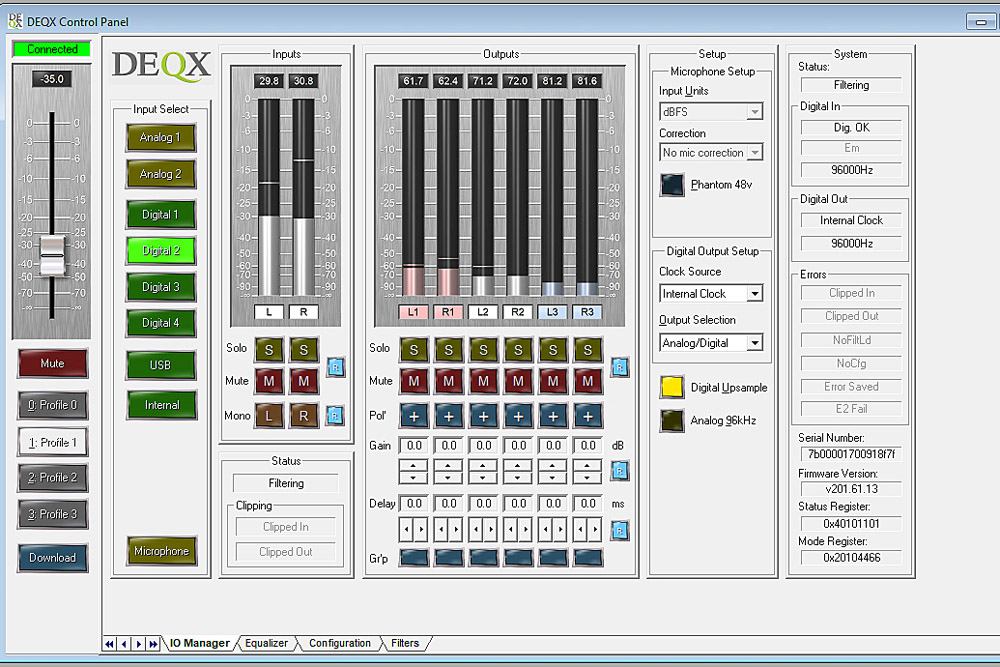
AL: The complexity of getting a passive network to get this right without using the Wilson Audio solution is next to impossible.
KR: Apart from linear phase crossovers the unique issue DEQX addresses is the significant measured phase response delays across the whole spectrum. We don’t just fix time alignment between the drivers we measure and correct the time alignment errors the drivers themselves always introduce. So while it’s worth the expense for Wilson Audio to mount their tweeter a few inches back to correct a ¼ millisecond problem, we commonly see some midrange frequencies being delayed up to several milliseconds which is very noticeable.
BJ: And then you’ve got other issues with insertion loss, etc.
KR: Yes, a passive speaker’s crossover’s resistors, inductors and capacitors add their own phase/timing errors as well as chewing up power. Their main problem is phase distortion – because it’s like there’s a rubber band between the amplifier and driver... that’s a slight exaggeration but you get the idea. When we go ‘active’ the crossover filters (DSP or analogue) go into separate amplifiers for each type of driver, so the amp’s output connects directly to its driver. This is the ideal arrangement because there’s no power lost but more important is that this direct connection from amp means the driver will track it almost instantly. But ‘almost’ remains the problem because it means phase errors at certain frequencies that DEQX must compensate for in advance.
BJ: I notice that in DEQX you can also implement Linkwitz-Riley or Butterworth crossovers. Why would users choose to do this when they have access to the linear phase steeper slope crossovers?
AL: Only perhaps at very low frequencies to avoid unnecessary latency, or if you are integrating or trying to setup a subwoofer. At very low frequencies, linear phase doesn’t provide the same degree of benefit.
KR: It’s also helpful for designers who want to compare traditional analogue filters with DEQX’s linear phase and impulse corrected. Hopefully the difference will be stark! Most consumer speaker designers are forced to use passive so they can DEQX to simulate what they will get using passive crossovers. Bill DuddIeston of Legacy Speakers fame was an early adopter of DEQX which allowed him to simulate many design variations before committing them to passive crossovers. It won’t be exactly the same because we’re now being a traditional analogue but ‘active’ crossover, where the advantages of any active design will be heard that won’t be translated to a passive speaker.
BJ: How does DEQX active crossover technology differ from the competitors like MiniDSP, Lyngdorf, Legacy Audio, etc.?
AL: No other company outside of the pro-audio world does FIR crossovers without requiring additional software (which is what MiniDSP does). It’s not an integrated system like DEQX.
KR: That’s right and most of these can’t do long convolution DSP so they focused on IIR, or Infinite Impulse response filters. It’s ironic that FIRs, meaning Fixed Impulse Response filters imply far more process to allow the timing/phase correction than IIR. However IIR is best for bass frequencies where we don’t notice timing issues nearly as much as in the midrange. If we use linear phase for bass crossovers or time correction it adds latency that may cause sync problems with video. As a rule of thumb try to keep latency under 15ms for video. In audio-only systems we can use linear phase crossover for bass as well, which roughly doubles the latency. Actually you can have both types in all DEQX models and select from up to four profiles via the remote.
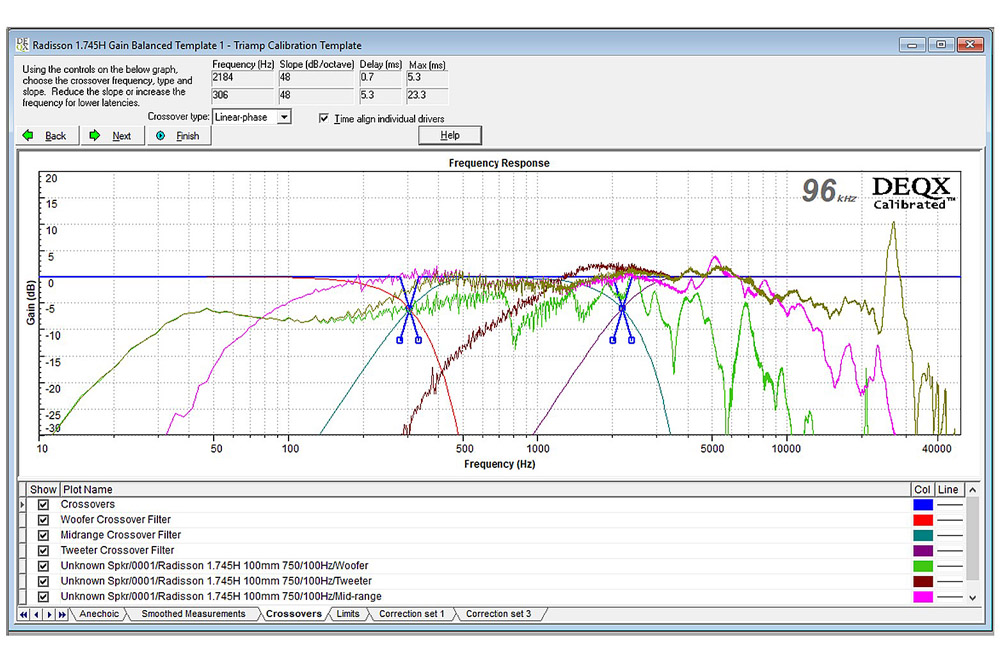 Crossover Calibration screen on DEQX Processor
Crossover Calibration screen on DEQX Processor
BJ: Linn have capability in their Space Optimization technology which allows the DSP to deal with the way notes decay at certain room modes as well as amplitude. Does the DEQX DSP tackle decay of notes? Or is that something you may look into in the future?
KR: I think all properly designed room corrections will do that in one way or another. The basic issue for room correction is that the dimensions of every room will excite the frequencies that align to those dimensions. So if our room is 10 feet high, 13 feet wide and 20 feet deep for example we’d expect to see problems around 110Hz, 90Hz and 60Hz respectively because those dimensions are roughly the wavelengths at those frequencies. Of course it’s not always that simple because the speaker’s design and placement within the room also influence the effects. Linn have a database of popular speakers where they’ve measured their dispersion effects and that can be helpful.
Our approach is to expect many variables in most rooms, so we take measurements at and around the listening position to see what’s happening in practice then clean that up. After that, some users may want to tweak and store a variety of room equalisations based on their hearing while looking at the actual before and after measurements, so it’s more hands on. All units except the Express-II come with our on-line DEQXpert installation so the user doesn’t have to read our 180 page manual!
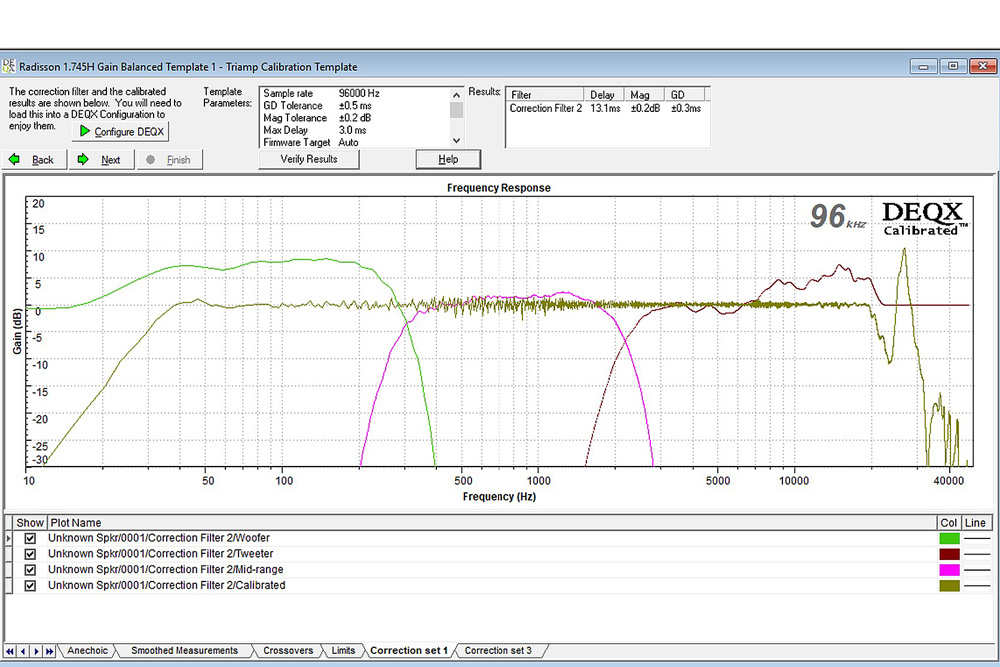 Corrected response on DEQX Processor
Corrected response on DEQX Processor
BJ: I understand the digital processing within DEQX is done at 24-bit 96 kHz resolution. In recent years other audio companies are promoting 24-bit 192 kHz or even 384 kHz. Do these higher resolutions provide any advantages to DEQX's DSP? Does DEQX plan to take advantage of them?
KR: We need to be clear that the only advantage of sample rates above about 96 kHz is that it’s easier and cheaper to design good ADCs and DACs. That’s because CD’s 44.1 kHz for example needs ‘brick-wall’ filters to get rid of the DAC’s switching frequencies that otherwise alias into the audio band. Apart from its 16-bit dynamic range the problem with 44.1 kHz is that these steep filters cause Group-Delay timing errors (phase-response errors) down towards 10 kHz. When we go to 96 kHz these phase-errors are inaudible with properly designed DAC filters, which by the way are rare. Most post-DAC filters these days cater for 192 kHz so their final anti-aliasing low-pass filter doesn’t roll off until 24/192’s bandwidth of 80kHz, compared to 40 kHz for 24/96 media. But 80 kHz is an octave too high for 24/96’s 40 kHz bandwidth and two octaves too high for CD’s 16/44.1’s 20 kHz bandwidth. This has a lot to do with the perception that 24/192 can sound better than 24/96. There simply is not audio content above 40 kHz even if we could hear it. So when we play CDs or 24/96 media on these DACs we’re only benefiting from the low-pass digital filters inside the DAC, and not the final analogue filters following the DAC, so not a fair comparison.
To maintain high resolution time correction across all frequencies we can actually hear, for every doubling of frequency-response we need four-times more DSP power. Our original processing was at 48 kHz but we had multiple DSPs and it was OK to go to 96 kHz. Our time domain convolution needs about 100x more processing power and memory than normal DSP based crossovers with parametric EQ for example. So we put considerable effort into our post-DAC filter design to maintain accurate group delay well over 20kHz.
One day we might allow users to choose the processing sample rate so they can hear the benefits of 96 kHz compared to 192 kHz processing, for example, and we do accept 192 kHz sources.
BJ: Aside from how the signal is treated once in the digital domain is it fair to say the Analogue to Digital Converter (ADC) and the DAC have the biggest influence in preserving the sound of the original signal? What choices has DEQX made in the selection and implementation of its ADC/DAC technologies?
KR: Yes. The DSP has 140dB dynamic range so there’s no distortion at all introduced by the DSP. The Analogue to Digital (ADC) and Digital to Analogue (DAC) is more difficult to make transparent. We did a lot of listening tests where we switched between a ‘wire’ and the signal running through the ADC, DSP and the DAC (with no filtering going on). Our dealer in New York asked a few reviewers and audiophiles to tell the difference – and they couldn’t. We have one of the country’s best design engineers, Dean Cooper, who’s been designing this stuff for 40 years. He did a review of the design after the HDP3 and that’s why there’s quite a big difference between the early DEQX units and now.
BJ: There’s certainly a lot packed into a DEQX (preamp, DAC, Streamer etc.) what does DEQX do to minimise the noise of digital circuits on analogue signals?
KR: That’s what Dean’s good at! He does a lot of EMC measurements and in fact EMC certifications for other companies with his own Faraday room. He’s able to optimise the board layout, power-supply noise and ensure proper filtering occurs in the right places. It’s complex when you have powerful processing going on near sensitive analogue signals. You need a combination of balanced signals, very low impedances everywhere to eliminate logic radiation and detailed ground layout.
BJ: You also offer the DEQXpert service to help users set up their DEQX. Can you tell us about this service?
KR: Our software, which is used to configure the DEQX, is called DEQX-Cal. It runs under Windows (or Apple if you have a Windows emulator). There is a learning curve. Originally it was very hard to use, to the point where I said “I can’t use this…” so we spent nearly two years making it suitable for me to use! Now we have the measurement and calibration wizards that make it infinitely easier to use. Even with the wizards though, you still have to have some understanding of what you’re doing.
Users that were familiar at least with DIY speaker design didn’t have a problem and once you figure it out it’s very quick. Eventually we realised most users, especially if they’re just adding it to passive speakers, just want to get going. It’s also why we’ve had a lot of resistance from dealers. They like to tell customers “take this amp or speaker home, try it, and if you don’t like it bring it back”. DEQX is different; you normally need to make measurements that mimic an anechoic measurement, so it’s not only a simple room measurement, although many users jump straight to the room measurement if they’re totally happy with their speakers already.
Either way we like to know our users are set up properly, unless they want to do it themselves, so we set up the DEQXpert on-line installation service that usually works out of Sydney and Denver. These is a complimentary service using Skype or by phone where we run the software for you step-by-step. The session typically takes around 2 hours. It’s a moderate extra cost for Express II users, who are often DIY and like to learn it themselves.
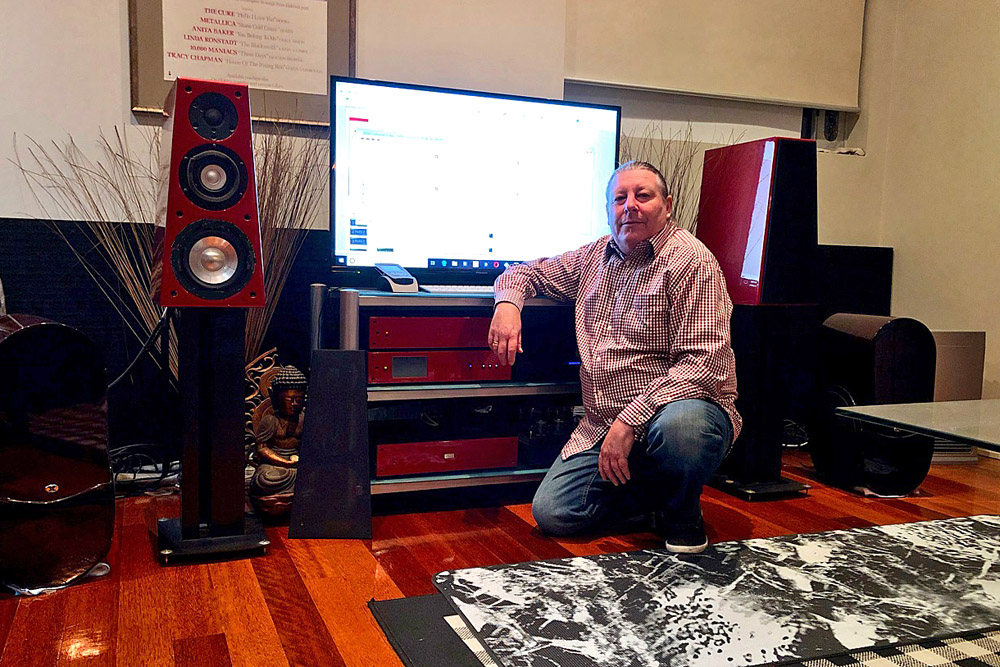 DEQX’s Alan Langford with one of the reference systems
DEQX’s Alan Langford with one of the reference systems
BJ: Tell us about the new DEQX amplifiers. I believe they're based on Hypex Ncore technology?
KR: We’ve wanted to offer amps for some time, but they’ve either been too expensive or not good enough. We’ve spent a lot of time investigating the options and we’ve found the Hypex Ncore to be really good and affordable. When you are doing an active system you need 2 or 3 amps per speaker so these bi-blocks and tri-blocks make that neat and easy. For example to make a 3-way active speaker from scratch would use two tri-blocks. Each chassis has two 250 watts into 4 ohms amps for bass and midrange plus a 100 watts amp (4 or 8 ohms) for tweeter only.
AL: One of the things about digital amplifiers is the interaction with speaker cables. So being able to place the amplifier at the speaker and have the shortest possible run of speaker cable is very beneficial especially for 3-way systems.
KR: With passive speakers it’s not an issue but when you have active speakers and with cables running to the bass, midrange and tweeter over a long distance there’s a chance of cable interaction. We did a CES show years ago with an OEM customer who’s 3-way system sounded brilliant before it was packed up for the show. Meanwhile, for aesthetics the three sets of cables had been grouped together tightly. Anyway, we got to the show and “holy … this is not what is used to sound like!” By chance I suggested ‘maybe’ the speaker cables were too close together because that was the only change since we heard it last and, sure enough, that’s what it was. I must admit this was with early generation D-class amps around 10 years ago. We’re not noticing that effect with the Ncore amps.
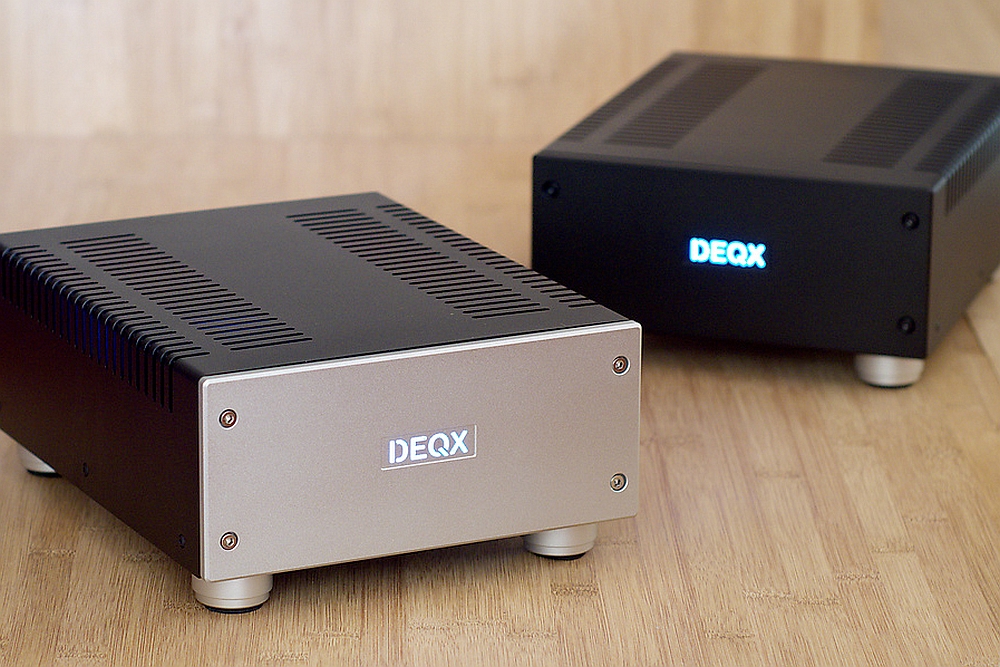 DEQX’s new A Series amplifiers
DEQX’s new A Series amplifiers
BJ: There are some speaker manufacturers now taking advantage of DEQX technology in their products, like Kyron Audio, Legend Acoustics, etc. Has this made you consider adding speakers to your product range?
KR: It’s in discussion but no decision yet, so stay tuned! But certainly, we like helping people who are building their own speakers. We’re totally happy to talk through what sort of drivers you could use (or not use) and make suggestions. That’s all part of the DEQXpert service, which by the way isn’t limited to a single consultation. Larry Owens is our DEQXpert in Denver who has a wealth of experience in the pro studio monitoring and mastering. He’s dealt with a lot of the most critical installations, and likewise, Alan has been involved in hundreds of installations. In Japan our DEQXpert has been a head of audio at NHK, Japan’s national broadcaster.
BJ: Is there anything I haven’t asked that you wanted to speak about?
KR: I guess our reason for being is that not a lot has changed in audio over the last 50 to 60 years in terms of speaker technology. It’s ridiculous. There are some designs starting to emerge like Kyron at the high-end and Bruno Putzey’s Kii. I notice that Meridian are promoting their latest flagship speaker’s active Group-Delay correction, so it’s starting. There just hasn’t been enough of a dramatic change with all these incremental changes over the years to enthuse more people to put down their ear pods. Most of today’s best audio experiences cost ten times more than the best 4K video… That’s crazy isn’t it?
I think that’s changing as more integrated active speakers and wireless speakers are coming out. Ultimately they need timing-coherence, frequency-response and resolution that’s accurately representing our media, particularly 24/96 that the vast majority of recordings for decades have been mastered at. I think you need Convolution DSP to do that affordably.
So the good news is that we’re starting from a low bar and the other good news is that the orders of magnitude for the required processing is getting very affordable.
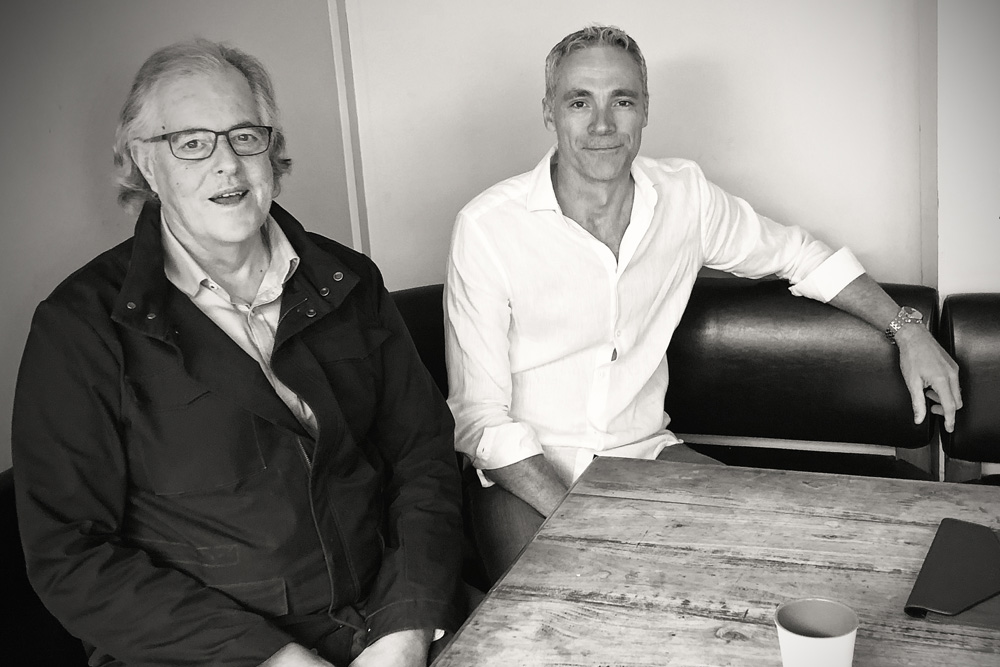
… Barry Jones
www.soundstageaustralia.com
NOTE: DEQX is celebrating its 21st Anniversary with a special offer! Get up to 33% off the Recommended Retail Price on a wide range of DEQX’s products. Offer available until the end of October 2019. For further details go to: https://www.deqx.com/21st_anniversary_sale/
DEQX
1 Roger Street
Brookvale NSW 2100
Australia
+61 2 9905 6277
www.deqx.com
